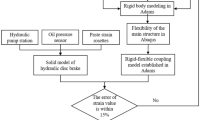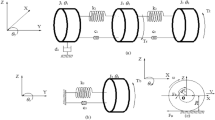Abstract
The stick–slip model of a Girling brake is composed of nonlinear and coupled differential equations that reproduce the friction occurring in this mechanical system. The brake is equivalent to a body sliding on a belt. The problem is very interesting since the possible solutions, which are very sensitive to the parameters of the system, show a chaotic behaviour. In this contribution, the model, which is designed following network method rules, is explained in detail and runs on standard electrical circuit simulation software to provide the displacement and the velocity of the sliding body and the phase planes. In comparison with other models, the considered system does not include dampers to get a more unstable behaviour. Furthermore, a suitable selection of parameters is implemented to reduce the computational time.








Similar content being viewed by others
References
Blau, P.J.: Friction Science and Technology. Marcel Dekker, New York (1986)
Dowson, D.: History of Tribology. Professional Engineering Publishers, London (1998)
Perry, S.S.: Progress in the pursuit in the fundamentals of tribology. Tribol. Lett. 10(1–2), 1–4 (2001)
Blau, P.J.: The significance and use of the friction coefficient. Tribol. Int. 34, 585–591 (2001)
Müser, M.H.: Theory and simulation of friction and lubrication. Lect. Notes Phys. 704, 65 (2006)
Hess, D.P., Soom, A.: Friction at a lubricated line contact operating at oscillating sliding velocities. J. Tribol. Trans. ASME 112(1), 147–152 (1990)
Armstrong-Hélouvry, B.: Control Mach. Frict. Kluwer Academic Press, Hingham (1991)
Courtney-Pratt, J.S., Eisner, E.: The effect of a tangential force on the contact of metallic bodies. Proc. R. Soc. A 238, 529–550 (1956)
Liang, J.W., Feeny, B.F.: A comparison between direct and indirect friction measurements in a forced oscillator. J. Appl. Mech. Trans. ASME 65(3), 783–786 (1998)
Powell, J., Wiercigroch, M.: Influence of non-reversible Coulomb characteristics on the response of a harmonically excited linear oscillator. Mach. Vib. 1(2), 94–104 (1992)
Johannes, V.I., Green, M.A., Brockley, C.A.: Role of rate of application of tangential force in determining static friction coefficient. Wear 24(3), 381–385 (1973)
Rabinowicz, E.J.: The nature of the static and kinetic coefficients of friction. J. Appl. Phys. 22(11), 1373–1379 (1951)
Stribeck, R.: Fundamental characteristics of the friction bearing and the roller bearing. Zeitschrift des Vereines Deutscher Ingenieure 46(46), 1341–1348 (1902)
Wojewoda, J., Stefanski, A., Wiercigroch, M., Kapitaniak, T.: Estimation of Lyapunov exponents for a system with sensitive friction model. Arch. Appl. Mech. 79(6–7), 667–677 (2009)
Coulomb, C.A.: Théorie des machines simples. Mémoire de Mathémathiques et de Physique de l’Academie royale des Sciences 10, 161–182 (1785)
Stefanski, A., Wojewoda, J., Wiercigroch, M., Kapitaniak, T.: Chaos caused by non-reversible dry friction. Chaos Solitons Fract. 16(5), 661–664 (2003)
Awrejcewicz, J., Olejnik, P.: Analysis of dynamic system with various friction laws. Appl. Mech. Rev. 58(6), 389–411 (2005)
Fu, W.P., Fang, Z.D., Zhao, Z.G.: Periodic solutions and harmonic analysis of an anti-lock brake system with piecewise-nonlinearity. J. Sound Vib. 246(3), 543–550 (2001)
Choi, H.S., Lou, J.Y.K.: Nonlinear behaviour and chaotic motions of an sdof system with piecewise non-linear stiffness. Int. J. Non-linear Mech. 26(5), 461–473 (1991)
Fling, R.T., Fenton, R.E.: A describing-function approach to antiskid design. IEEE Trans. Veh. Technol. 30(3), 134–144 (1981)
Perko, L.: Differential Equations and Dynamical Systems. Springer, New York (1991)
Yeh, E.C., Day, G.C.: Parametric study of antiskid brake systems using Poincaré map concept. Int. J. Veh. Des. 13, 210–232 (1992)
Girling Auto website http://www.girlingauto.com/
Awrejcewicz, J., Olejnik, P.: Numerical and experimental investigations of simple non-linear system modelling a Girling duo-servo brake mechanism. In: Proceedings of DETC’03 ASME, Chicago (2003)
Awrejcewicz, J., Olejnik, P.: Occurrence of stick–slip phenomenon. J. Theor. Appl. Mech. 45(1), 33–40 (2007)
Awrejcewicz, J., Olejnik, P.: Improvement of the Lyapunov exponents computations by extension of time series. In: Proceedings of the 11th World Congress in Mechanism and Machine Science, Tianjin, China (2003)
Alhama, F., Marín, F., Moreno, J.A.: An efficient and reliable model to simulate microscopic mechanical friction in the Frenkel–Kontorova–Tomlinson model. Comput. Phys. Commun. 182, 2314–2325 (2011)
Marín, F., Alhama, F., Moreno, J.A.: Modelling of nanoscale friction using network simulation method. Comput. Mater. Continua 43(1), 1–19 (2014)
Marín, F., Alhama, F., Moreno, J.A.: Modelling of stick-slip behaviour with different hypotheses on friction forces. Int. J. Eng. Sci. 60, 13–24 (2012)
González-Fernández, C.F., Alhama, F.: Heat transfer and the network simulation method. In: Horno, J. (ed.), Network simulation method, Research signpost, Trivandrum (2001)
Microsim Corporation Fairbanks, PSpice 6.0, Irvine, California (1994)
Nagel, L.W.: SPICE2: A Computer Program to Simulate Semiconductor Circuits. University of California, Berkeley (1975)
Kreith, F.: The CRC Handbook of Thermal Engineering. CRC Press, London (2000)
Mills, A.F.: Heat Transfer. Prentice Hall, Concord (1998)
González-Fernández, C.F., Alhama, F., López-Sánchez, J.F.: Application of the network method to heat conduction processes with polynomial and potential-exponentially varying thermal properties. Numer. Heat Transf. Part A Appl. 33(5), 549–559 (1998)
Horno, J., González-Fernández, C.F., Hayas, A.: The Network Method for solutions of oscillating reaction–diffusion systems. J. Comput. Phys. 118(2), 310–319 (1995)
Soto, A., Alhama, F., González-Fernández, C.F.: An efficient model for solving density driven groundwater flow problems based on the network simulation method. J. Hydrol. 339(1–2), 39–53 (2007)
Zueco, J., Alhama, F.: Inverse determination of heat generation sources in two-dimensional homogeneous solids: application to orthotropic medium. Int. Commun. Heat Mass Transfer 33(1), 49–55 (2006)
Van de Vrande, B.L., Van Campen, D.H., De Kraker, A.: An approximate analysis of dry-friction-induced stick-slip vibrations by a smoothing procedure. Nonlinear Dyn. 19, 157–169 (1999)
Elmer, F.J.: Nonlinear dynamics of dry friction. J. Phys. A Math. Gen. 30(17), 6057–6063 (1997)
Andrianov, I.V., Awrejcewicz, J., Kudra, G.: Iterational processes and Padé approximants. Facta Univ. Mech. Autom. Control Robot. 4(17), 279–285 (2005)
Tariku, F.A., Rogers, R.J.: Improved dynamic friction models for simulation of one-dimensional and two-dimensional stick-slip motion. J. Tribol. 123, 661–669 (2001)
Vladimirescu, A.: The SPICE Book. Wiley, New York (1994)
Kielkowski, R.: Inside SPICE. McGraw Hill, New York (1994)
Acknowledgments
We are grateful to Dr. Parlitz, Full Professor in the University of Göttingen, for his interesting and convenient tips.
Author information
Authors and Affiliations
Corresponding author
Rights and permissions
About this article
Cite this article
Marín, F., Alhama, F., Meroño, P.A. et al. Modelling of stick–slip behaviour in a Girling brake using network simulation method. Nonlinear Dyn 84, 153–162 (2016). https://doi.org/10.1007/s11071-015-2312-x
Received:
Accepted:
Published:
Issue Date:
DOI: https://doi.org/10.1007/s11071-015-2312-x




